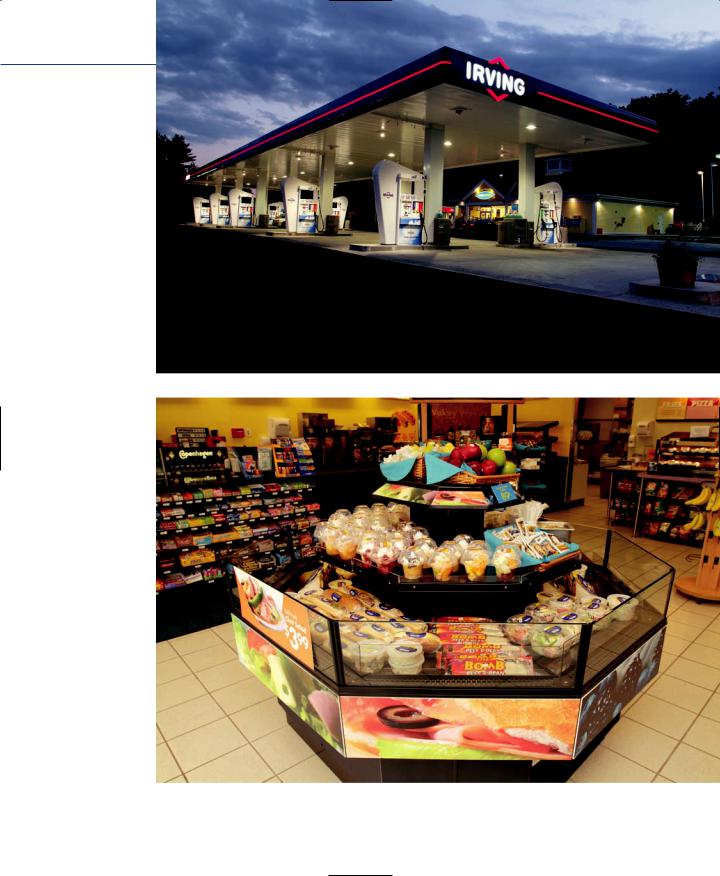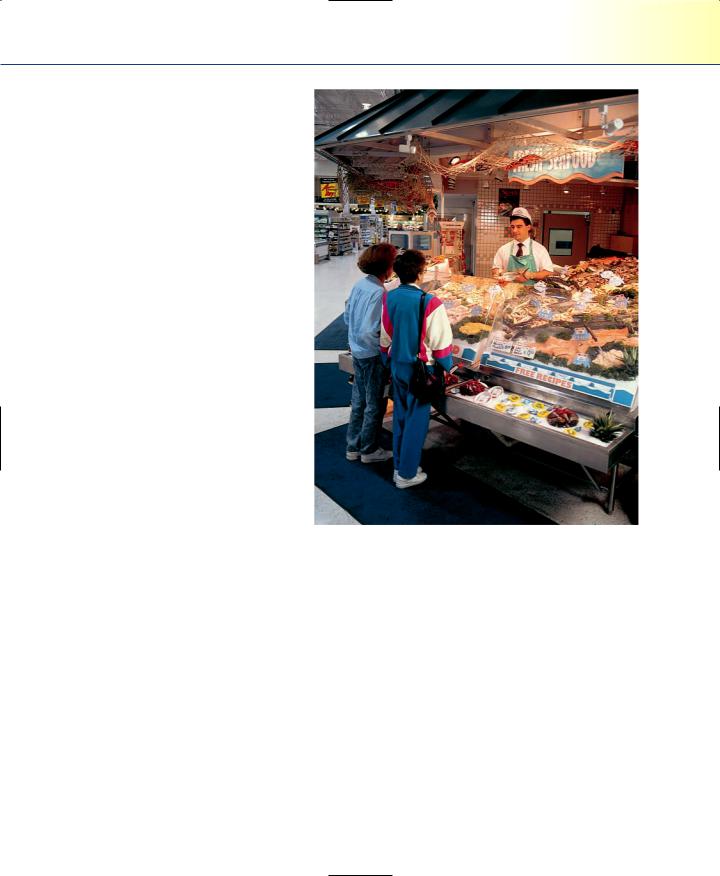
- •CONTENTS
- •PREFACE
- •Content—Benefits for Students
- •Content—Benefits for Instructors
- •Features of the Book for Students and Instructors
- •Supplementary Materials
- •Acknowledgments
- •What Is Hospitality Management?
- •The Manager’s Role in the Hospitality Industry
- •Why Study in a Hospitality Management Program?
- •Planning a Career
- •Employment as an Important Part of Your Education
- •Getting a Job
- •Employment at Graduation
- •The Outlook for Hospitality
- •Summary
- •Managing Change
- •Demand
- •Supply
- •Workforce Diversity
- •The Impact of Labor Scarcity
- •Summary
- •The Varied Field of Food Service
- •The Restaurant Business
- •The Dining Market and the Eating Market
- •Contemporary Popular-Priced Restaurants
- •Restaurants as Part of a Larger Business
- •Summary
- •Restaurant Operations
- •Making a Profit in Food Service Operations
- •Life in the Restaurant Business
- •Summary
- •Chain Restaurant Systems
- •Independent Restaurants
- •Franchised Restaurants
- •Summary
- •Competitive Conditions in Food Service
- •The Marketing Mix
- •Competition with Other Industries
- •Summary
- •Self-Operated Facilities
- •Managed-Services Companies
- •Business and Industry Food Service
- •College and University Food Service
- •Health Care Food Service
- •School and Community Food Service
- •Other Segments
- •Vending
- •Summary
- •Consumer Concerns
- •Food Service and the Environment
- •Technology
- •Summary
- •The Evolution of Lodging
- •Classifications of Hotel Properties
- •Types of Travelers
- •Anticipating Guest Needs in Providing Hospitality Service
- •Service, Service, Service
- •Summary
- •Major Functional Departments
- •The Rooms Side of the House
- •Hotel Food and Beverage Operations
- •Staff and Support Departments
- •Income and Expense Patterns and Control
- •Entry Ports and Careers
- •Summary
- •The Economics of the Hotel Business
- •Dimensions of the Hotel Investment Decision
- •Summary
- •The Conditions of Competition
- •The Marketing Mix in Lodging
- •Product in a Segmented Market
- •Price and Pricing Tactics
- •Place—and Places
- •Promotion: Marketing Communication
- •Summary
- •The Importance of Tourism
- •Travel Trends
- •The Economic Significance of Tourism
- •The United States as an International Tourist Attraction
- •Businesses Serving the Traveler
- •Noneconomic Effects of Tourism
- •Summary
- •Motives and Destinations
- •Mass-Market Tourism
- •Planned Play Environments
- •Casinos and Gaming
- •Urban Entertainment Centers
- •Temporary Attractions: Fairs and Festivals
- •Natural Environments
- •On a Lighter Note. . .
- •Summary
- •Management and Supervision
- •The Economizing Society
- •The Managerial Revolution
- •Management: A Dynamic Force in a Changing Industry
- •What Is Management?
- •Summary
- •Why Study Planning?
- •Planning in Organizations
- •Goal Setting
- •Planning in Operations
- •The Individual Worker as Planner
- •Long-Range Planning Tools
- •Summary
- •Authority: The Cement of Organizations
- •Departmentalization
- •Line and Staff
- •Issues in Organizing
- •Summary
- •Issues in Human-Resources Management
- •Fitting People to Jobs
- •Recruiting
- •Selection and Employment
- •Training
- •Retaining Employees
- •Staff Planning
- •Summary
- •The Importance of Control
- •Control and the “Cybernetic Loop”
- •Tools for Control
- •Summary
- •Leadership as Viewed by Social Scientists
- •Why People Follow
- •Leadership Theories
- •Communication
- •The Elements of Leading and Directing
- •Developing Your Own Leadership Style
- •Summary
- •A Study of Service
- •Rendering Personal Service
- •Managing the Service Transaction
- •How Companies Organize for Service
- •Summary
- •INDEX

Competition with Other Industries |
177 |
are “deals,” which include coupons, games, and promotional merchandise. Deals are intended to enhance the value of the product offered—and to stimulate immediate purchase. Deals have become an increasingly common inducement to customers. The use of deals by customers peaked in the late 1990s and has been fluctuating since then, representing as much as one-fourth of all meal occasions in some years. A study by Adjoined Consulting found that over 40 percent of survey respondents said that coupons influence their choice on where to dine. However, Restaurants and Institutions magazine contends that there is little relationship between coupons and loyalty.13
Coupons. Coupons are often offered in connection with very-low-product-cost fountain drinks (a product cost as low as 2 or 3 percent). As a result of their low cost, couponing these items has a limited impact on the operation’s profit margin. During the off season, however, coupons discounting main meal items are more common.
Games. Games cost considerably less than couponing main meal items. They enhance value by offering a little excitement—the possibility of an all-expenses-paid vacation in some exotic locale, for instance. Moreover, lots of small prizes (french fries, coffee, or the like) make the possibility of winning fairly likely—and winning anything is usually a pleasant experience.
Promotional merchandise. Promotional merchandise such as toys or glassware is often called a “self-liquidator” because the merchandise is usually sold at cost, limiting the impact of the deal on the promotional budget. Typically, merchandise comes in sets of three or four to encourage repeat patronage: “Collect all four!” Such items may also be distributed as part of a meal package for children.
In more upscale operations, special events are a common form of promotion. Special ethnic menus or celebrations of holiday events such as Valentine’s Day or Mother’s Day fit this category.
An increasingly common form of highly targeted sales promotion involves frequentguest programs. These programs offer rewards to good customers and encourage repeat patronage. Frequent-guest programs increase guest loyalty and yield valuable information on customers, which can be used in future marketing programs.
Competition with Other Industries
It is an axiom of economics that people’s wants will expand indefinitely but that their resources are limited. Most people would like a new car and a vacation in Europe or the Caribbean as well as the latest in DVD, stereo, and computer equipment. They would also like to dine in the finest restaurants. The problem is, however, most must choose, as few can afford all of that. Give up dining out in the best the local restaurant

178Chapter 6 Competitive Forces in Food Service
scene has to offer for the next year or so and you may have the cost of that vacation. Forgo lunch at your favorite restaurant and brown-bag it for six weeks and you can probably save the price of a new DVD and two or three rentals. Thus, food service is, in a very real way, in generic competition with all other industries, especially those providing leisure services and conveniences.
Some industries, however, challenge food service on its own turf, offering directly competitive products. We will concentrate our attention on these retailers here. Convenience stores offer their own variety of quick service from locations that are so numerous that they seem to be just around the corner from wherever you may be. Supermarkets are not as numerous as convenience stores, but they are conveniently located, and virtually everyone visits them in the course of a week. Both are formidable competitors for food service.
CONVENIENCE STORES
Although their most frequent customers are males under age 35, C-stores, as they are often called, are visited once or twice a month by most of the adult population. A significant part of C-store sales are directly competitive with food service sales, especially beverages (fountain drinks and coffee) and sandwiches. Because nearly all C-stores have microwave equipment and offer prepared foods, these retail units can compete for more than the snack market. Many offer a service deli and a variety of QSR foods. Some C-stores have a point of distribution from one of the major QSR chains located in the store. Although food service is relatively more labor-intensive than other C-store products, it offers a higher contribution to overhead and profits—roughly 60 percent as compared with 30 percent for other products. According to the National Association of Convenience Stores:
■Over 50 percent of convenience stores offer some kind of prepared food.
■Average sales for food service in convenience stores in 2005 exceeded $128,000.
■Industry food service sales exceeded $17.9 billion in 2005.
■Food service sales represent 13.3 percent of in-store sales for convenience stores.14
Food service now accounts for the third largest category of convenience store sales, after cigarettes and packaged beverages.
The Alimentation Couche-Tard and 7-Eleven companies are the largest of those which are solely in the business of convenience stores. Many of the other large convenience store operators are oil companies including ExxonMobil and BP North America although some oil companies are leaving the retail business and focusing on sales and distribution of gasoline instead. Oil companies that continue to operate convenience stores have four

Convenience stores continue to compete with quick-service restaurants. (Courtesy of Irving Oil Corporation.)
179

180Chapter 6 Competitive Forces in Food Service
distinct advantages over many other C-store operators. First, because of their large gasoline sales, they can afford prime corner locations. Second, they have the backing of cash-rich corporations. Third, they are able to sell gas at lower prices. Finally, consumers can use their gasoline credit card to make their purchase, which is a major convenience.
SUPERMARKETS
Restaurateurs and retailers selling food for consumption at home have always been in competition. For some years, restaurants’ share of that market has been increasing. That struggle is intensifying as a result of sharpened competitive practices in the grocery business and changing patterns in leisure-time usage. We will discuss the grocery business in this section and look briefly at the changing patterns in leisure in the next section. Clearly, the two developments are interrelated.
Supermarkets have customers from 100 percent of households over a 52-week period—in effect, everybody. With this kind of exposure and market share, they are formidable competitors for the food dollar. A state-of-the-art store today emphasizes food service, and many grocery stores are adding food courts and full-scale restaurants, including ethnic-themed operations as well as brand-name QSRs. McDonald’s, Burger King, Pizza Hut, and Taco Bell all operate units in supermarkets, and contract companies such as ARAMARK have developed branded programs for supermarkets. We discussed the proliferation of PODs earlier, and here we can see it as a part of the blurring of concepts. When is a restaurant “sort of not exactly” a restaurant? When it’s part of a grocery store offering food service. Or perhaps we should just say that grocery stores are a very significant part of the ever-increasing competition for the consumer’s food dollar.
Supermarkets are endangering restaurants’ home meal replacement market share. According to the Food Marketing Institute, a grocery trade industry organization, the percentage of supermarkets with take out food sections rose by over 50 percent in a ten-year period to 94 percent in 2006. Further, a study by the same association found that younger consumers were equally likely to buy takeout food in supermarkets as in quickservice restaurants.15 Supermarket takeout food is generally less costly to the consumer than restaurant takeout food, and grocery stores offer wider variety. The convenience of being able to get a few staples—milk or bread for breakfast—while picking up dinner is undeniable. According to the Food Marketing Institute, dinner is by far the most popular meal for takeout and one-person households are most likely to purchase prepared meals from supermarkets.
Restaurants, however, have the advantage of a service culture and higher-quality food. Supermarket managers are often rooted in a retail mind-set (although there is evidence that this is changing). This being said, some supermarkets that do offer prepared foods to go take it to a near art form. Stew Leonard’s (in Connecticut and New

Competition with Other Industries |
181 |
Grocery stores are increasing their share of the food service market. (Courtesy of Publix Supermarkets.)
York) offers a variety of foods prepared to go including marinated turkey, chicken prepared various ways, and filet mignon. The store has been described as one part amusement park because of the mix of exceptional service, special activities, and quality products. Whole Foods is another “nontraditional” type of supermarket that offers a strong selection of prepared foods, fried rice, rotisserie items, and wood-fired pizza. Partnering with food service operators—or hiring managers and chefs away from restaurants—supermarkets are making efforts to improve their performance. The competition between food service and supermarkets promises to continue to be stiff especially as supermarkets continue to try harder for this piece of the business.
THE HOME AS COMPETITION
As the baby boomers move into their middle years and greater family responsibilities, the attractions of staying at home increase. Baby boomers continually indicate that
